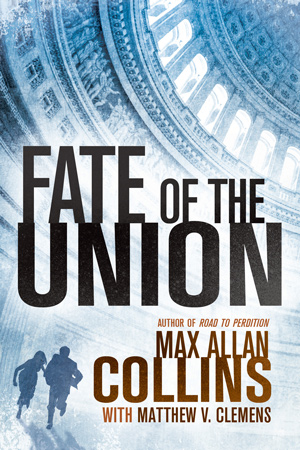The first of eight episodes of QUARRY will be on Cinemax on September 9 at 10 p.m. (I assume that’s eastern time).
Obviously this has been a long time coming, but I think the wait will have been worth it. Already the series has resulted in Hard Case Crime reissuing the first five books, with a new book coming in October (QUARRY IN THE BLACK), a four-issue comic book series early next year, and another novel (QUARRY ON TARGET) that I will write later this year.
The news about the series and its debut is all over the Internet – probably a couple of dozen write-ups. Here are several that should serve to catch you up.
The Early Word has something of a publishing slant. Collider has advance images, and Den of Geek is nicely opinionated.
A big Kindle sale is coming up later this week, featuring assorted titles of mine in the Mystery, Thriller & Suspense category. Each book will be $1.99. The sale begins July 1 and runs through July 31.
Here are the specific titles:
[Note from Nate: For your convenience, I’ve linked the Amazon logo to each book’s Amazon page, and the text title to each book’s info page on our website.]
 CHICAGO LIGHTNING
CHICAGO LIGHTNING
 WHAT DOESN’T KILL HER
WHAT DOESN’T KILL HER
 SUPREME JUSTICE
SUPREME JUSTICE
 THE TITANIC MURDERS
THE TITANIC MURDERS
 THE LONDON BLITZ MURDERS
THE LONDON BLITZ MURDERS
 THE HINDENBURG MURDERS
THE HINDENBURG MURDERS
 THE WAR OF THE WORLDS MURDER
THE WAR OF THE WORLDS MURDER
 THE PEARL HARBOR MURDERS
THE PEARL HARBOR MURDERS
 TRUE CRIME
TRUE CRIME
 THE MILLION-DOLLAR WOUND
THE MILLION-DOLLAR WOUND
Beginning 7/1/2016, go here:
https://www.amazon.com/b?node=13819722011.
If you go there before that date, the page may not show the new promotion, or it may be empty. If that’s the case, check back on July 1, the official start date.
The Rock ‘n’ Roll Hall of Fame discussion continues. Here’s a great comment from Mike Dennis that you may have missed:
royalties.
As far as the 1958-63 (Elvis/Army – Beatles invade US) era is concerned, I’ve thought about that. It was not the most fertile period for rock & roll. Think about 1958. Rock & roll was in danger of disappearing altogether. I’m sure you remember. Radio DJs were breaking records on the air, clergymen from coast to coast were pounding their pulpits over this sinful, new music. It was not a given than the music would survive, rather it was held together by a loose gathering of young artists and the eager teenagers who had fallen under their spell. The adults couldn’t stand it.
Then Elvis entered the Army, Jerry Lee Lewis self-destructed on his disastrous tour of the UK, and Buddy Holly died in February of 1959. That was really the end of the period where this raw, exciting music was being made by mostly young Southern boys, independent of each other, music crafted and honed in the dirt-road joints of the emerging South. The songs, and the artists who recorded them, were a natural outgrowth of a post-World War II America, reflecting (like the film noir that rose during that period) all the alienation that existed in the country at that time.
The songs spoke only to young people, while the artists were generally sex-crazed hillbillies sent out on the road with no adult supervision. Elvis was the King of Rock & Roll. Jerry Lee Lewis was supposed to inherit the throne following his British tour. Holly represented the music’s sensitive side. But with all three of them gone by early 1959, there was a vacuum at the top. The major record companies saw their opening and moved in. They swiftly rounded up a stable of compliant, cute, barely-talented artists who were willing to do what they were told for a shot at stardom. Rock & roll songs were no longer written on the back of napkins or on paper bags, they were written in the Brill Building by calculating, businesslike songwriters whose job it was to turn out hits that had been scrubbed clean of sexuality.
Also, I’m glad you pointed out the role of the Wrecking Crew in the making of so many great records. I would like to note there was a British version of the Wrecking Crew — I’m not sure if they had a slick name like that — that played on most of the British Invasion records. One noteworthy example is the Kinks’ first two records, YOU REALLY GOT ME and ALL DAY AND ALL THE NIGHT. The opening buzzsaw guitar chords were played by Jimmy Page, not Dave Davies as is commonly thought. I met Page in 1966, right after he joined the Yardbirds and he told me all about those sessions. Until then, he was a first-call studio player in London and he and a few other guys played on all the British Invasion records (all, that is, except the Beatles, the Stones, and maybe a couple of others).
That said, I still don’t consider Buffalo Springfield as anything more than a one-hit wonder. Laura Nyro was a great songwriter, as you pointed out, but I don’t think she’s worthy of induction in the R&RHOF. There are artists I would like to see in the Hall, like Johnny Rivers, the Monkees, and the Association, but as long as the Hall is itself not worthy of having them, I’m not going to get too upset over their omission.
Mike, thanks for this articulate, insightful mini-essay. Much of what you say I agree with, but I think you (in a way characteristic of some who highly value Elvis, Jerry Lee and Buddy Holly) underestimate some of what was going on in the between-Elvis-and-the-Beatles years. Some very exciting stuff was happening, on the east coast particularly. You know I am a big Bobby Darin fan – his version of his own “Early in the Morning” is far superior to the rushed Buddy Holly cover, and Darin cut many strong rockers backed by great Atlantic Records session men. I would also cite artists like Bobby Vee and Bobby Rydell (two more of the much-maligned “Bobbys” and neither on a major label) as real rock artists.
Then there’s Phil Spector’s Wall of Sound, and I can’t agree about the Brill Building output – not when we’re talking Bacharch & David, Goffin & King, Mann & Weil, Pompous & Shuman, Greenwich & Barry, Leiber & Stoller. A lot of that was anything but scrubbed of sexuality.
You mention 1958. Rock was not disappearing – not with the Everly Brothers, Ricky Nelson, Danny and the Juniors, the Coasters, Little Anthony and the Imperials, and – oh yeah – a guy named Chuck Berry…all charting. From ‘59 to ‘62, there were many greats and near-greats making hit records: Lloyd Price, Ritchie Valens, Dion and the Belmonts, Freddy Cannon (“Woo!”), Ray Friggin’ Charles, Jackie Wilson, Johnny Cash, Del Shannon (opened for him!), the Shirelles, Gary U.S. Bonds, Joey Dee and the Starlighters, and Gene Pitney. Not chopped liver! And not a major record company artist in the bunch.
The supposed dearth of rock post-Elvis and pre-Beatles strikes me as highly exaggerated. I wonder how many people like me – I’m now the ancient age of 68 – lived through all of these eras of rock and loved every one.
A couple of footnotes. The Buffalo Springfield played at the Masonic Temple in Davenport, Iowa, within a year of when my band the Daybreakers played there, when we opened for the Rascals and Gary Puckett. Buffalo Springfield was amazing and brave – they played extended, very loud solos prefiguring what every band would be doing in a year or two, and alienating much of the Iowa teenage audience. And my God was the fringe on Neil Young’s leather jacket long!
Same venue, same year. Gene Pitney and several other acts, including the Turtles (opened for them twice!), appeared in a kind of caravan-of-stars format. Pitney tore the place up, his vocals just towering. Then half-way through the set, he spoke for the first time, telling the audience in a hoarse voice, almost a whisper, that he apologized for doing so poorly, but he had a bad cold and was fighting laryngitis. Then he sang THE MAN WHO SHOT LIBERTY VALANCE.
Finally, MS. TREE fans may enjoy this fun, smart podcast in which two comic book experts review (favorably) the story “One Mean Mother.”
M.A.C.






